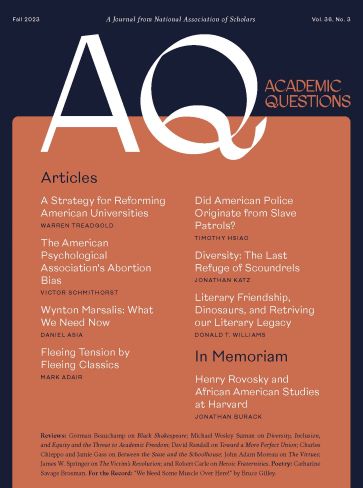Diversity, Inclusion, and Equity and the Threat to Academic Freedom, Martin Lopez Corredoira, Tom Todd, Erik J. Olsen eds., 2022, Imprint Academic, pp. 222, $29.90 paperback.
In 2016, the new chair of my department at UCLA announced that DEI (Diversity, Equity, and Inclusion) was taking center stage at the university. This was not a local phenomenon. As noted and, in part, documented in the recent National Association of Scholars (NAS) report, Ideological Intensification, DEI has spread aggressively through institutions of higher learning throughout the Western world. DEI was originally conceived as a way to promote and ensure the full participation and involvement of all, especially academically marginalized and underperforming groups. Unfortunately, in our increasingly politicized institutions of higher learning, DEI ideas have come to form the basis of a new puritanical religion whose adherents relish taking offense at the sins of nonbelievers and casting out heretics.
In 2023, academia finds itself far removed from the old liberal ideal of a politically neutral institution open to all viewpoints and dedicated to the dispassionate search for and dissemination of knowledge and truth. Instead, we increasingly find ourselves enveloped by a monoculture all too often piloted by a regressive, authoritarian left that polices behavior, language, and even thought to meet its “progressive” ideological requirements. In this atmosphere, “diversity” has come to mean that everyone must think alike and have the same “enlightened” ideas. Inclusion has come to mean that if you disagree with the de rigueur agenda, you are not welcome and should be shunned or canceled. Equity has come to mean that people are to be treated differently and held to different standards based on their race, gender, or other identity markers to overcome the oppression that is surely to blame for everyone otherwise not ending up in the same place.
Diversity, Inclusion, and Equity and the Threat to Academic Freedom sets out to document and discuss the radical changes in academia wrought by DEI (referred to in the book, in line with the title, as DIE). What can and cannot be talked about, researched, and taught in institutions of higher learning have been fundamentally altered in recent years. The book aims to show the dangerous excesses in DEI prevalent today. Notable cases from around the world are presented—abuses of power, censorship, and witch hunts that constitute a pattern that has not only led to absurdities and considerable human suffering, but also threatens to destroy the university itself. A wide variety of eminently qualified authors from around the world (Canada, Chile, Finland, Germany, Italy, Japan, South Africa, Spain, Sweden, United Kingdom, United States) weigh in, most recounting their own personal experiences from within academia. The editors hope the book will instigate debate to stanch the bleeding and turn things around. Of that, time will tell.
The book contains twenty-six chapters divided into five thematic sections. Half of the chapters are reprints (from sources such as Quillette, Bari Weiss’s substack Common Sense [now rebranded as the Free Press], and City Journal) and half are original contributions to this volume.
The leading DEI issue throughout most of the affected world has been gender. The conceptual distinction between sex (biology and nature) and gender (culture and nurture) was an important intellectual development. But modern gender ideology seems to have lost its moorings from empirical reality. In this regard, Philip Carl Salzman offers a strong piece on how modern feminism and science are incompatible. Whereas science entails an open exploration designed to test and expand knowledge, feminism has become a closed ideology driven by the quest to advance the political and economic interests of women. Research findings not supportive of the party line are vigorously rejected. In another compelling article on gender, Constatin Polychronakis, a professor of pediatrics and genetics at McGill University in Canada, explains how he lost his teaching gig for giving a lecture on DSDs (variably “disorders of sexual differentiation” or “difference in sexual development”) that was not sufficiently in line with DEI’s more nonbinary-friendly priorities. Also of note are pieces on the gender-based threat to academic freedom in universities in Sweden (Ivar Apri), issues of gender parity in the classical music world in Sweden (Martin Malmgren), and harassment campaigns (Andrei Yafaev) and transgender activism (Tom Todd) in academia.
Race and ethnicity is the second central DEI issue, although one less salient internationally in more homogeneous societies and in this book. As Chief Justice Roberts said, “It is a sordid business, this divvying up by race.” But we live in an age where racial problems are highlighted in discussions of most major social and political issues. In opposition to current “enlightened” notions, physicist Lawrence M. Krauss compellingly argues that science must be race- (and gender- and religion-) blind. He explains how recent dramatic anti-racist posturing and policies are detrimental to the principles and necessary protocols of academic science. Moreover, demands to root out “systemic racism” in academic science have created an environment in which free speech and open inquiry, hallmarks of good scholarship, are threatened.
In another powerful piece, Heather Mac Donald argues that academia’s monolithic and misguided belief in systematic racism is eroding American institutions and the very principles upon which Western civilization is based. Within academia, other credible explanations for racial disparities in society beyond discrimination, such as culture, family structure, and behavior, are dismissed and denounced. The ideal of nonpartisan neutrality has been betrayed, and those who question the prevailing diversity ideology are inhibited, silenced, and even driven from their jobs. Mac Donald argues that campus orthodoxy amounts to “conformity to a lie” with devastating results for higher education and society in general.
DEI programs themselves have become ubiquitous on campus. In 2021, my undergraduate alma mater, The Ohio State University, spent $13.4 million on the hiring of 132 “diversicrats.” Of this volume’s chapters focusing on these programs, the standout piece is Janice Fiamengo’s analysis of how many academic job applications today are focused less on academic qualifications and more on demonstrated commitment to DEI principles. In addition to often excluding white males from applicant pools, the purging of non-left-wing candidates is also commonplace. She persuasively argues that as commitment to individual ability is sacrificed for the sake of political correctness, the research preeminence of the scientific institutions of the West is in peril. Philip Carl Salzman contributes another fine piece on how the educational social justice tsunami is swamping ideas of merit, achievement, and excellence. Not only has social advocacy replaced the search for reality and truth, its simplistic explanation (always oppression and discrimination) for differing results across gender, race, and other categories of people is dubious. The ultimate result is that our universities, responsible for educating coming generations of doctors, lawyers, bureaucrats, and legislators, are doing their best to discredit and destroy American and Canadian culture, liberal individualism, freedom, capitalism, and Western civilization. Another noteworthy chapter discusses the pernicious effects of DEI programs on the physical and biological sciences (Patrick Labelle).
In this Golden Age of the tattler and the self-righteous, taking exception to the moral absolutism all too often embodied in DEI can yield serious negative outcomes such as censorship, deplatforming, and harassment. David Benatar writes cogently on the deplatforming of Flemming Rose, culture editor of the Danish newspaper Jyllands-Posten that published drawings and cartoons depicting Mohammed, from a lecture he had been invited to give at the University of Cape Town, South Africa. Benatar skillfully dismantles the reasons given for the disinvitation and explains the dangers of the cowardly and misguided efforts of those responsible.
Peter Boghossian convincingly explains how he felt he had no choice but to resign his academic position at Portland State University. He describes how the university has been transformed from a bastion of free inquiry into a social justice factory focused on race, gender, victimhood, and grievance. Dorian Abbot forcefully explains how the pervasiveness of a totalitarian woke ideology in academia led MIT to cancel a lecture he was to give there. His offense was having openly advocated for academic freedom and merit-based evaluations. He ends his piece with pointed recommendations for those subject to similar treatment.
Following on Abbot’s advice, Peter Domingos compellingly discusses principles useful for fighting cancel culture. He provides an illustration of how a social justice bully was defeated on Twitter. Also noteworthy are Alessandro Strumia’s discussion of his infamous run-in with the diversity police within the international physics community and at CERN for his research and statements about gender, Jordan Peterson’s reflections on the Faculty of Divinity at Cambridge rescinding his fellowship offer, and Gerhard Amendt and Tom Todd’s discussion of the campaign to derail a conference on family and domestic violence in Germany.
The book does an impressive job covering a lot of ground, and here I merely offer a taste of the highlights. One other noteworthy chapter is Erik J. Olssen’s discussion of problems with the rise of “feminine culture” in academia, which is included in a general considerations section at the end of the book.
The chapters are mostly written in a journalistic style with an aim toward a general educated audience interested in the topic. Unfortunately, much of the book is not as accessible as it should be, indicating a lack of adequate editing, here in the face of the notably difficult task of agglomerating the work of authors who do not all share English as their first language. Moreover, beyond the responsibilities of the three editors, all indications are that the publisher provided no copy editor. A good number of the original pieces created for this volume need serious revision. The worst of these articles is rambling, incoherent, and littered with basic English errors. Luckily for the reader, half of the articles are reprints from sources that obviously took their editing responsibilities more seriously. Certainly not all of the original pieces are problematic in this regard. For example, Janice Fiamengo’s aforementioned cogent and well-written piece on DEI programs is not a reprint. The major problem with some of the original articles is mostly organizational. But again, it is the job of the editors to ensure flow and coherence. Most of the articles have content of value but getting at it should not be such a challenge.
Another gripe against the publisher and the editors is that they should at least have included in a footnote that Jordan Peterson’s rescinded fellowship offer at Cambridge was reversed with an invitation in September 2021 to participate in research seminars with the Faculty of Divinity. He subsequently spoke there in November 2021. This book was published in September 2022.
Given the above criticisms, I am hesitant to recommend the book, but it does bring together an abundance of important contemporary material from a wide range of significant voices on this challenging multi-faceted issue. If nothing else, the volume makes clear that DEI programs must be dismantled, at least as they are currently constructed, if higher education is to function and survive as a healthy institution. This is a tall order, but the recent Supreme Court decision in SFFA v. Harvard (2023) eliminating affirmative action in college admissions might help. The integrity of the academic mission and the university itself are at stake.
Michael Wesley Suman is a sociologist and continuing lecturer in the Department of Communication at UCLA; [email protected]. His letter to the UCLA Academic Senate Program Review committee, “We Must Re-Establish Standards in Higher Education,” appeared in our FOR THE RECORD column in the Spring 2023 issue.
Photo by Steve Johnson on Unsplash














